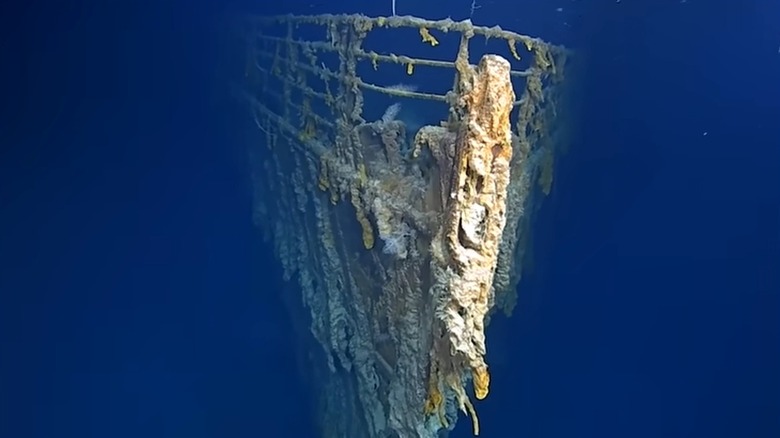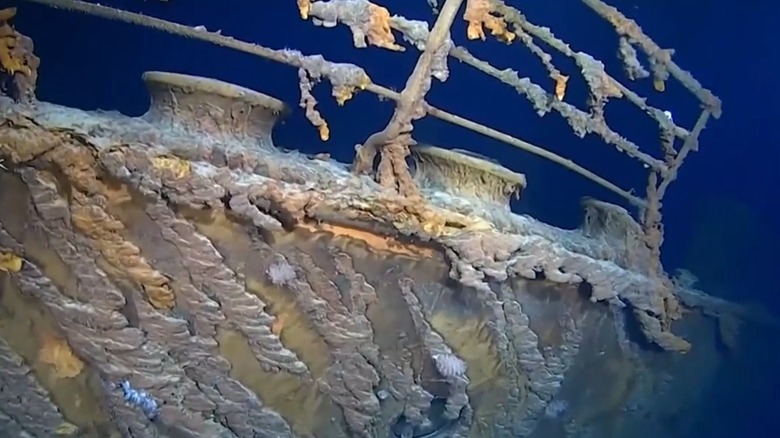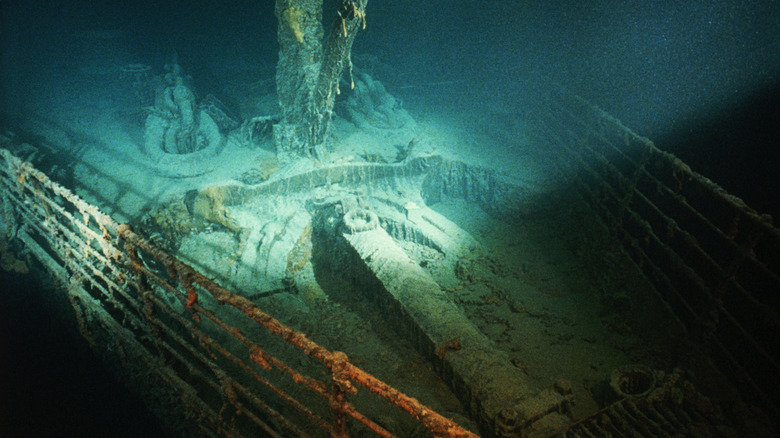Why The Titanic Shipwreck Could Disappear In Your Lifetime
Considered the most immense and opulent passenger vessel of its time, the Titanic boasted 10 decks, a length of 852.5 feet, and a variety of amenities such as a swimming pool (the first ship to offer one), a luxurious bath house, and even an in-house barber. Sadly, as most are aware, while the Titanic excelled in size and lavishness, it equally lacked emergency preparedness. On the ship's voyage toward New York in 1912, the crew was unable to avoid striking an iceberg, and the mammoth vessel disappeared under the surface of the Atlantic.
Titanic rests at a depth of around 12,500 feet or 2.3 miles below the surface. This means the ship resides in the ocean's "midnight zone," named for its unceasing darkness. At around 380 atmospheres of pressure, the crash site is dangerous for humans to visit, as evidenced by the recent Ocean Gate submersible disaster. In fact, there are only 10 subs that are certified to go to the Titanic. However, time is running out.
The remains of this iconic shipwreck are breaking down due to corrosion, living bacteria, and ocean currents. Some microbes are feeding off the ship's metal surfaces, while others are consuming the corrosive rust. In addition, researchers have also discovered organisms causing the production of Sulfur, which then turns into sulfuric acid, further eroding the ship's surface.
How long before Titanic vanishes completely?
The wreckage of the Titanic is so deep, it wasn't even discovered until more than 70 years after it sank. However, as difficult as it is to believe, the deepest depth any person has explored in the ocean far surpasses that of the historic shipwreck.
Since the mid-80s, researchers have been visiting the Titanic regularly, taking note of the vessel's worsening condition year-over-year. It's impossible to definitively pin down when the ship will be completely gone, but there are plenty of theories. In 2016, some scientists hypothesized that the Titanic would cease to exist as early as 2030. However, more recently, researchers have postulated the wreck may not disappear until closer to 2040.
An expedition in 2024 discovered that a large section of the Titanic's bow railing had toppled off the deck and into the seabed. Even if you've seen pictures of the wreckage before, it has likely changed, perhaps dramatically. Further investigations have also identified areas of the ship that are in the process of collapsing, such as the officers' quarters, causing a cascading and damaging effect on surrounding structures.
Why you wouldn't want to visit the Titanic
With such a momentous piece of history slowly fading beneath the ocean, perhaps you're thinking you should visit the wreck of the Titanic while you can. Well, not so fast. If what went wrong in OceanGate's Titan sub disaster wasn't enough to dissuade you from going, there are some other reasons to give you pause. For starters, OceanGate was the only means for tourists to visit the Titanic, and it has since shuttered its doors following the tragic events of its last voyage.
If you were somehow able to get aboard one of the few submarines capable of making the journey, it's not an easy one. According to RMS Titanic Inc. (the organization that owns the salvage rights to the wreckage), the descent from the surface takes around 2 hours and 30 minutes, plus two hours to return to the surface.
There may be a single porthole for viewing the ocean depths, but for most of the journey, it'll be nothing but a pitch-black abyss. Finally, after you reach the Titanic, the lighting on the sub may only grant you up to two meters or around six feet of visibility.


